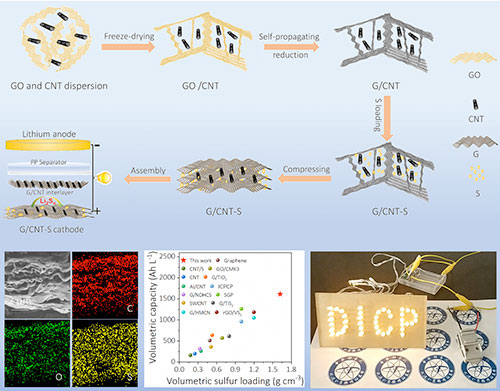| May 22, 2019 | |
Graphene/carbon nanotube aerogels for ultrahigh energy-density Li-S batteries(Nanowerk News) A research group led by WU Zhongshuai from the Dalian Institute of Chemical Physics (DICP) of the Chinese Academy of Sciences developed high volumetric-energy-density and long-life lithium sulfur (Li-S) batteries based on the free-standing, densely compact, and integrated cathode. |
|
| These Li-S batteries are derived from three-dimensional (3D) interconnected porous graphene and carbon nanotube (CNT) aerogels, simultaneously serving as sulfur host and interlayer. Their findings were published in Nano Energy ("Free-standing integrated cathode derived from 3D graphene/carbon nanotube aerogels serving as binder-free sulfur host and interlayer for ultrahigh volumetric-energy-density lithiumsulfur batteries"). | |
| Lithium-sulfur (Li-S) batteries, as one highly competitive alternative for commercially available high-energy-density lithium metal batteries, have drawn considerable attentions on account of high theoretical gravimetric and volumetric energy density. | |
| However, the practical applications of Li-S batteries have been hampered by several issues, including low mass densities of nano sulfur, intrinsically poor electrical conductivities of sulfur, large volume expansion of sulfur particle during cycling, and shuttling effect of lithium polysulfide, all of which result in low volumetric energy density and limited cyclability of Li-S batteries. | |
| Hence, improving the gravimetric and volumetric energy density at the same time, as well as prolonging the cycle stability of the Li-S batteries, is the bottleneck of the applied research of Li-S batteries. | |
 |
|
| Schematic of 3D graphene/carbon nanotube aerogels for ultrahigh volumetric-energy-density lithium-sulfur batteries. (Image: SHI Haodong and HOU Xiaocheng) | |
| The scientists developed a free-standing, compact, conductive and integrated cathode, constructed by compressing graphene/carbon nanotubes aerogels, simultaneously serving as bi-functionalities of binder- and metal-current-collector-free sulfur host and interlayer for Li-S batteries. | |
| The integrated cathode displayed high compaction density, outstanding mechanical flexibility and high electrical conductivity, which could endow the cathode with ultrahigh volumetric mass density, volumetric-energy-density, and exceptionally long-term cycling stability with an extremely low decay rate over 500 cycles at 2°C. | |
| This proposed integration cathode strategy would open numerous opportunities for constructing binder-free, current-collector-free, high-sulfur-loading and compact cathodes toward high-volumetric-energy-density and flexible Li-S batteries. |
| Source: Chinese Academy of Sciences | |
|
Subscribe to a free copy of one of our daily Nanowerk Newsletter Email Digests with a compilation of all of the day's news. |
